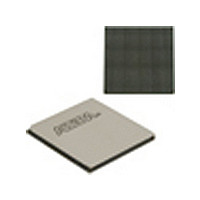EP4SGX530HH35C2N Altera, EP4SGX530HH35C2N Datasheet - Page 309

EP4SGX530HH35C2N
Manufacturer Part Number
EP4SGX530HH35C2N
Description
IC STRATIX IV FPGA 530K 1152HBGA
Manufacturer
Altera
Series
Stratix® IV GXr
Datasheets
1.EP4SGX110DF29C3N.pdf
(80 pages)
2.EP4SGX110DF29C3N.pdf
(1154 pages)
3.EP4SGX110DF29C3N.pdf
(432 pages)
4.EP4SGX110DF29C3N.pdf
(22 pages)
5.EP4SGX110DF29C3N.pdf
(30 pages)
6.EP4SGX110DF29C3N.pdf
(72 pages)
7.EP4SGX530HH35C2N.pdf
(1145 pages)
Specifications of EP4SGX530HH35C2N
Number Of Logic Elements/cells
531200
Number Of Labs/clbs
21248
Total Ram Bits
27376
Number Of I /o
564
Voltage - Supply
0.87 V ~ 0.93 V
Mounting Type
Surface Mount
Operating Temperature
0°C ~ 85°C
Package / Case
1152-HBGA
Family Name
Stratix® IV
Number Of Logic Blocks/elements
531200
# Registers
424960
# I/os (max)
560
Process Technology
40nm
Operating Supply Voltage (typ)
900mV
Logic Cells
531200
Ram Bits
28033024
Operating Supply Voltage (min)
0.87V
Operating Supply Voltage (max)
0.93V
Operating Temp Range
0C to 85C
Operating Temperature Classification
Commercial
Mounting
Surface Mount
Pin Count
1152
Package Type
FCHBGA
Lead Free Status / RoHS Status
Lead free / RoHS Compliant
Number Of Gates
-
Lead Free Status / Rohs Status
Compliant
Available stocks
Company
Part Number
Manufacturer
Quantity
Price
- EP4SGX110DF29C3N PDF datasheet
- EP4SGX110DF29C3N PDF datasheet #2
- EP4SGX110DF29C3N PDF datasheet #3
- EP4SGX110DF29C3N PDF datasheet #4
- EP4SGX110DF29C3N PDF datasheet #5
- EP4SGX110DF29C3N PDF datasheet #6
- EP4SGX530HH35C2N PDF datasheet #7
- Current page: 309 of 1154
- Download datasheet (32Mb)
Chapter 8: High-Speed Differential I/O Interfaces and DPA in Stratix IV Devices
Source-Synchronous Timing Budget
Source-Synchronous Timing Budget
Figure 8–25. Bit Orientation in the Quartus II Software
February 2011 Altera Corporation
Differential Data Orientation
Differential I/O Bit Position
This section describes the timing budget, waveforms, and specifications for
source-synchronous signaling in the Stratix IV device family. LVDS I/O standards
enable high-speed data transmission. This high data transmission rate results in better
overall system performance. To take advantage of fast system performance, it is
important to understand how to analyze timing for these high-speed signals. Timing
analysis for the differential block is different from traditional synchronous timing
analysis techniques.
Instead of focusing on clock-to-output and setup times, source synchronous timing
analysis is based on the skew between the data and the clock signals. High-speed
differential data transmission requires the use of timing parameters provided by IC
vendors and is strongly influenced by board skew, cable skew, and clock jitter. This
section defines the source-synchronous differential data orientation timing
parameters, the timing budget definitions for the Stratix IV device family, and how to
use these timing parameters to determine a design’s maximum performance.
There is a set relationship between an external clock and the incoming data. For
operations at 1 Gbps and a serialization factor of 10, the external clock is multiplied by
10. You can set phase-alignment in the PLL to coincide with the sampling window of
each data bit. The data is sampled on the falling edge of the multiplied clock.
Figure 8–25
Data synchronization is necessary for successful data transmission at high
frequencies.
figure is based on the following:
■
■
■
inclock/outclock
Serialization factor equals the clock multiplication factor
Edge alignment is selected for phase alignment
Implemented in hard SERDES
data in
shows the data bit orientation of the ×10 mode.
Figure 8–26
MSB
9
8
shows the data bit orientation for a channel operation. This
7
6
10 LVDS Bits
5
4
3
2
1
LSB
0
Stratix IV Device Handbook Volume 1
8–31
Related parts for EP4SGX530HH35C2N
Image
Part Number
Description
Manufacturer
Datasheet
Request
R

Part Number:
Description:
CYCLONE II STARTER KIT EP2C20N
Manufacturer:
Altera
Datasheet:

Part Number:
Description:
CPLD, EP610 Family, ECMOS Process, 300 Gates, 16 Macro Cells, 16 Reg., 16 User I/Os, 5V Supply, 35 Speed Grade, 24DIP
Manufacturer:
Altera Corporation
Datasheet:

Part Number:
Description:
CPLD, EP610 Family, ECMOS Process, 300 Gates, 16 Macro Cells, 16 Reg., 16 User I/Os, 5V Supply, 15 Speed Grade, 24DIP
Manufacturer:
Altera Corporation
Datasheet:

Part Number:
Description:
Manufacturer:
Altera Corporation
Datasheet:

Part Number:
Description:
CPLD, EP610 Family, ECMOS Process, 300 Gates, 16 Macro Cells, 16 Reg., 16 User I/Os, 5V Supply, 30 Speed Grade, 24DIP
Manufacturer:
Altera Corporation
Datasheet:

Part Number:
Description:
High-performance, low-power erasable programmable logic devices with 8 macrocells, 10ns
Manufacturer:
Altera Corporation
Datasheet:

Part Number:
Description:
High-performance, low-power erasable programmable logic devices with 8 macrocells, 7ns
Manufacturer:
Altera Corporation
Datasheet:

Part Number:
Description:
Classic EPLD
Manufacturer:
Altera Corporation
Datasheet:

Part Number:
Description:
High-performance, low-power erasable programmable logic devices with 8 macrocells, 10ns
Manufacturer:
Altera Corporation
Datasheet:

Part Number:
Description:
Manufacturer:
Altera Corporation
Datasheet:

Part Number:
Description:
Manufacturer:
Altera Corporation
Datasheet:

Part Number:
Description:
Manufacturer:
Altera Corporation
Datasheet:

Part Number:
Description:
CPLD, EP610 Family, ECMOS Process, 300 Gates, 16 Macro Cells, 16 Reg., 16 User I/Os, 5V Supply, 25 Speed Grade, 24DIP
Manufacturer:
Altera Corporation
Datasheet:












